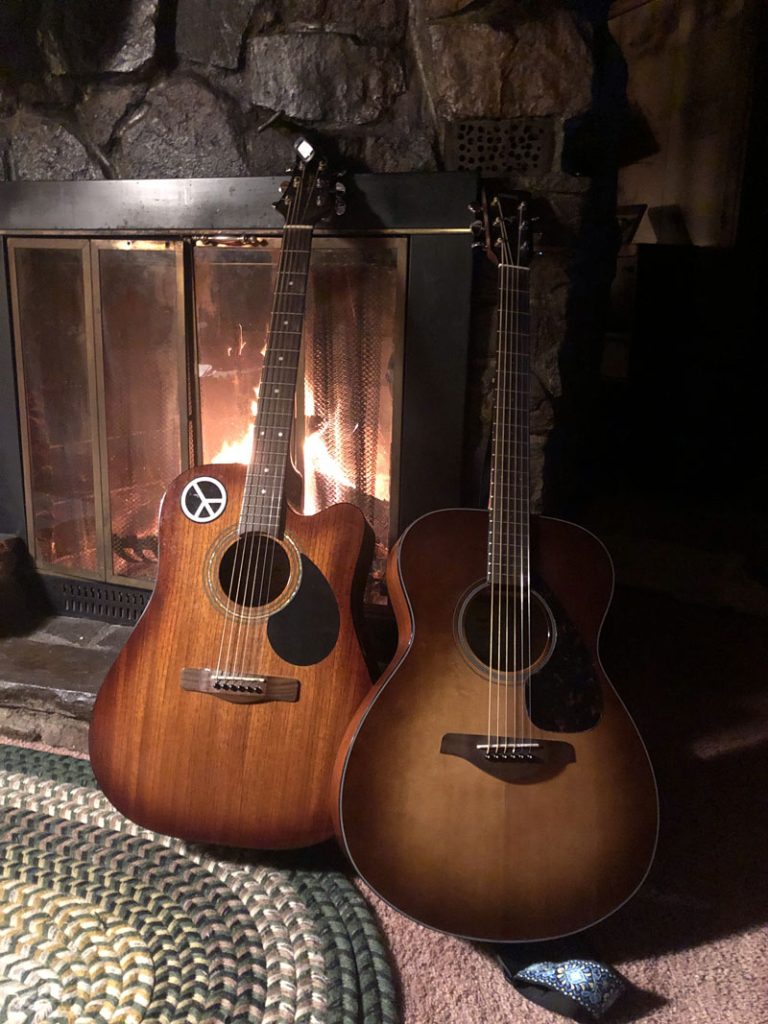
by Beth Dolinar, contributing writer
E-minor is my favorite.
Most people learning to play guitar will agree that Em is their favorite—probably because it’s two fingers on two strings close together. It’s easy to get to, it’s fairly common in beginner songs, and it sounds sad but not too sad.
E-minor was the first chord I learned when I started to learn to play the guitar, a development in my post-pandemic life prompted by both a new friendship and a lifelong dream.
Coming of age in the 70s, I longed to be the things I was not; I was the girl with short wavy hair who played the saxophone, and I wanted to be the girl with long, straight hair and a guitar. My parents were musicians and music teachers, and our house was always filled with music, but it was piano (which I also played) and marching band music, not folky guitar stuff.
Still, that upbringing wired my brain for music, and I suspected that a leap from saxophone to guitar would be challenging, but not impossible.
The dream of playing guitar hid there in the back of my mind all these years, brought forth occasionally when I’d hear a Joni Mitchell song and then shuffled back to the corner when life got busy.
In summer 2022, I bought a guitar. I went to the guitar store, selected a Yamaha acoustic six-string that was the right size for me, strummed it a few times for good measure, looked at the price tag and bought it, grabbing a few free picks from the bowl on the counter on my way out.
I’d taken a first step toward that adolescent dream. The purchase coincided with, and was largely inspired by my newfound love for bluegrass music. While I’ve mostly been a fan of folk and occasionally country music—and knew that the roots of both could be found in bluegrass–I’d never heard much of or about bluegrass.
And then came a new friendship with a bluegrass fan. The first day I met him, I noticed the bluegrass stickers on his car. He travels to bluegrass festivals, has a vinyl collection of the music and, most inspiring of all, he plays guitar.
What a revelation it was, to listen to Bill Monroe and Earl Scruggs and the Nitty Gritty Dirt Band and Alison Krauss. To learn that bluegrass bands usually have a mandolin player but not a drummer. To follow the careers of young artists like Billy Strings and Molly Tuttle. To think that all these years this music was out there, and I wasn’t paying attention.
It’s been said that most country songs are three chords and the truth. Within a few days of owning the guitar, I could play C, G and Em. With the help of YouTube tutors, I quickly added D, D7, Am, A and the most difficult of all, F.
With eight chords, I built a repertoire of mostly folk tunes. Some Dylan, some John Prine, some Joni and some Everly Brothers. Bluegrass tunes are trickier, but I’m working on it.
My friend and I play and sing together; he’s more advanced and can pick out the melodies while I strum. Although I sing in tune, I don’t have a pretty voice, but no matter. There’s something about sitting on the porch in the evening, playing the songs we know, singing with and to each other.
I will never be Joni, or Molly Tuttle or Alison Krauss. They started playing and singing when they were young. Learning something new isn’t so easy for an adult, but it’s worth the effort.
This week, I’m learning to play the old Dylan tune, “If Not for You.” There’s a tricky quick, syncopated chord change in the riff, from G to D to C.
I don’t have it yet, but I’m getting there.
***
 About the author: Beth Dolinar is a writer, Emmy-award winning producer, and public speaker. She writes a popular column for the Washington “Observer-Reporter.” She is a contributing producer of documentary length programming for WQED-TV on a wide range of topics. Beth has a son and a daughter. She is an avid yoga devotee, cyclist and reader. Beth says she types like lightning but reads slowly — because she likes a really good sentence.
About the author: Beth Dolinar is a writer, Emmy-award winning producer, and public speaker. She writes a popular column for the Washington “Observer-Reporter.” She is a contributing producer of documentary length programming for WQED-TV on a wide range of topics. Beth has a son and a daughter. She is an avid yoga devotee, cyclist and reader. Beth says she types like lightning but reads slowly — because she likes a really good sentence.

